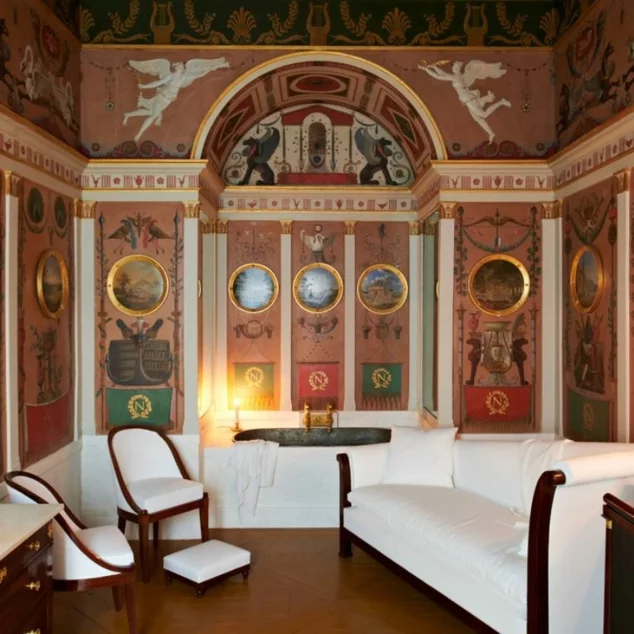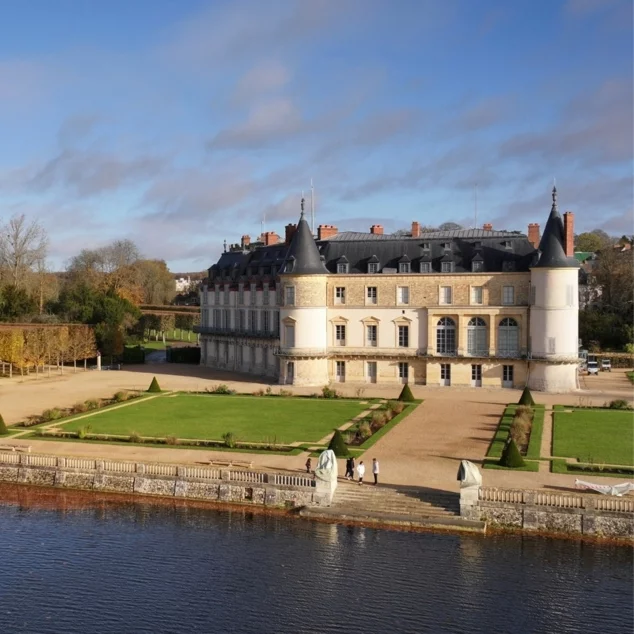History
article | Reading time8 min
History
article | Reading time8 min
Rambouillet is the unique example of a castle which knew at the same time the Old Regime, the Empire and the Republic.
To discover the history of the castle, it is to enter the intimacy of one of the favorite stays of the princes, kings and presidents since nearly six centuries. But the castle de Rambouillet is best known for its recent history. That of the presidential occupation which has just ended!
Jealously kept secret for many years, some private spaces are gradually opening to the public, revealing the secrets of their history. Did you know, for example, that more than half of the presidents of the Republic have stayed here?
It all began in 1895 when Felix Faure, President of the Third Republic, decided to make Rambouillet a summer residence. A true haven of peace, the place is ideal for combining family life and high-level diplomatic meetings, in a relaxed style.
© Laurent Gueneau / CMN
Can you imagine all the confidences exchanged here? Many foreign heads of state or crowned heads have been invited to Rambouillet: from David D. Eisenhower to John F. Kennedy, from Nikita Khrushchev to Mikhail Gorbachev, from the Emperor of Japan to Queen Elizabeth II.
It was also in Rambouillet that President Giscard d'Estaing chose to organize, in 1975, the first G6 meeting in history, which brought together the heads of state of the 6 most industrialized countries!
However, the presidents did not "invent" Rambouillet. On the contrary, they are part of a long tradition of occupation... Let's go back in time !
© Archives nationales
It is necessary to admit it: the place has everything to please! Located in the Yvelines, about fifty kilometers from Paris, Rambouillet is first of all easy to reach. Neither too far, nor too close, it is a perfect refuge to enjoy a bit of peace and quiet away from the power. Add to that the presence of one of the most beautiful forests in Ile-de-France, renowned for the quality of its hunting , and we understand why Rambouillet was so popular!
The first to perceive the exception of the place is called Jean Bernier. Advisor to King Charles V, he acquired a small manor house here in 1368 which he transformed into a fortified castle. We are then in the middle of the Hundred Years War and the English are not far away...
© 4vents / CMN
Towards the end of the 14th century, Rambouillet was acquired by the powerful Angennes family. The castle is gradually transformed into a residence of pleasure where it is good to live. It remained in the family for nearly three centuries!
THE personality of the family to remember? Catherine de Vivonne (1588-1665), wife of Charles d'Angennes, a great figure of the "Précieuses .
Did you know that? King François I died at the castle of Rambouillet. He was in poor health and fell ill during a hunt near Rambouillet. His friend, Jacques d'Angennes, hurriedly brought him back to the castle to treat him. In vain: he gives his last breath in the night of March 30, 1547.
© RMN-Grand Palais (musée du Louvre) / Michel Urtado
© Antoine Tchydemian-Meyer / CMN
© Antoine Tchydemian-Meyer / CMN
At the turn of the 17th century, the last heir of the d'Angennes family, beset by debts, is forced to cede the castle and the surrounding lands to his main creditor: Joseph-Jean-Baptiste Fleuriau d'Armenonville, finance steward of Louis XIV. One spends without counting! 140,000 pounds and then another 500,000 were invested in the development of a French garden! A colossal sum for the time.
Perhaps he should have refrained, because a king and his son are now looking towards Rambouillet...
© 11H45 / CMN
The house of the Count of Toulouse, prince of blood
Facing Louis XIV and the Count of Toulouse, his legitimate son Fleuriau d'Armenonville was not the favorite of the king... In 1704, he is asked to leave the place!
Having become the residence of a prince of the blood, the castle was embellished by the best craftsmen of the time, who came from the Versailles yard of course. Unlike the d'Angennes, the Count of Toulouse made it his main place of residence, far from the intrigues of the court.
A love marriage in the 18th century for the son of a king, can you believe it?
It took place in 1723, in great secrecy. The chosen one is called Marie-Victoire-Sophie de Noailles. For her, nothing is too good: the count offers her a sumptuous apartment decorated with rocaille woodwork, the assembly apartment. The result was a fulfilling and discreet family life around their only son, Louis-Jean-Marie, Duke of Penthièvre.
© Hervé Lewandowski / CMN
These two generations were enough to make Rambouillet, in the words of Saint-Simon, a"prodigious land" in which Louis XV came regularly to stay.
The Duke of Penthièvre, whose fortune was considerable, launched a new project, this time in the park. In the 1770's, he created an English garden with a number of buildings, such as the charming shell house, which still exists today. The heart of Rambouillet then beat to the rhythm of the Age of Enlightenment!
Exquisitely refined, everything here is the latest fashion. However, Rambouillet remains a castle on a human scale where it is good to live in the shadow of power.
© Reproduction Benjamin Gavaudo / CMN
Rambouillet becomes the property of the king!
A story of covetousness, we say? Louis XVI has been eyeing Rambouillet for many years... He was looking for a refuge to protect himself from the pressure of Versailles and to indulge his passion for hunting in complete peace! The Duke of Penthievre could not oppose the wishes of his royal cousin...
The King bought the castle in 1783, for the sum of 16 million pounds, which was 100 times more than Fleuriau d'Armenonville had paid a century earlier!
© RMN-Grand Palais / Agence Bulloz
Louis XVI ordered the construction of an experimental farm in Rambouillet to accommodate a flock of merino sheep imported from Spain.
The gardens are used as a nursery to test the acclimatization of species from botanical travels ! Keep your eyes open during your next visit: bald cypresses, tulip trees, ginkgo biloba and many others still adorn the park of Rambouillet.
© Bergerie Nationale
The only "hitch" in the story? His wife Marie-Antoinette did not like Rambouillet. However, Louis XVI reserved a nice surprise for her: a superb dairy and its menagerie specially designed for her by the famous painter Hubert Robert.
But nothing makes it: the Trianon of the castle of Versailles makes its happiness!
© Colombe Clier / CMN
In 1804, Napoleon takes possession of a castle in very bad state, damaged by the Revolution. Important works are then engaged. The Emperor wanted to make Rambouillet a place of retreat where he could live simply, surrounded by his family between two military campaigns.
The work carried out at that time changed the appearance of the castle forever: a wing was destroyed with dynamite! The façade was redesigned and a new apartment was built for the Emperor. The gardens were not forgotten: nearly 40,000 trees were planted.
Napoleon liked Rambouillet. He came there very regularly and became attached to the staff of the place: as a proof, the janitor of the castle will even have his place in his will!
Would you like to learn more about Napoleon's life in Rambouillet? Read our dedicated article.
© Jean-Pierre Delagarde / CMN
When the monarchy is restored in 1815, Louis XVIII reinvests the castle of Rambouillet and engages some works there.
His brother and successor, Charles X, was very attached to the place for having often hunted there at the time of Louis XVI. He found refuge there with his family following the Three Glorious (revolutionary days of July 27, 28 and 29, 1830). And it is here that he renounces to the throne, on August 2, 1830.
© RMN-Grand Palais (Château de Versailles) / image RMN-G
The new king, Louis-Philippe, is not interested at all in the castle of Rambouillet which is then proposed to the rent until Napoleon III, indignant by the fate reserved to one of the favorite stays of his uncle, decides to restore it then to lodge his cousin there.
The history of the castle could have stopped the day after the fall of the Second Empire... But, a new twist: what better place than Rambouillet to serve as a presidential residence?
Would you like to know more about this new page in the history of the castle? Go back to the top of this page, up to the first paragraph !
© Archives nationales
The Centre des monuments nationaux, which has been managing Rambouillet since 2009, is restoring and promoting this exceptional heritage. The abandonment of the official use of the castle will allow to open to the public new spaces until now reserved to the president and to his guests !
Behind a strongly reworked architecture, exceptional decorations are hidden, making Rambouillet a formidable conservatory of styles, taste and fashions. Let's take the example of the Count of Toulouse's bathroom or, more surprisingly, the guest rooms and their modernist decor from the 1950s, as decided by President Auriol!
Closed to the public for many decades, these rooms were gradually restored to their former glory. The objective? To finally reveal the backstage life of its glorious inhabitants, whether they were princes of blood, kings, emperors or presidents of the Republic!
© Château de Rambouillet / CMN


















